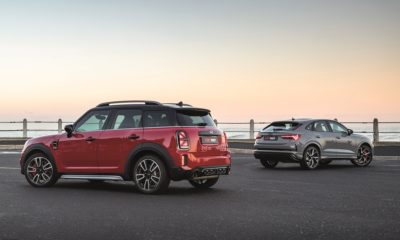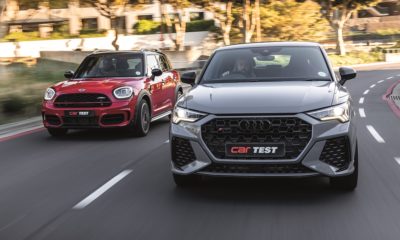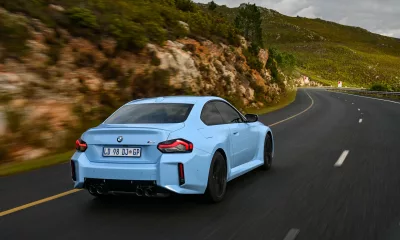As their badges – RS and JCW – would suggest, both the Audi Q3 and Mini Countryman are top-dog crossovers, fitted with bombastic turbopetrol engines and enough model-specific exterior items to trumpet their flamboyant performance-orientated personas. The most notable items distinguishing them from their garden-variety stablemates are their deep bumpers, flared wheelarches, RS- and JCW-specific alloy wheels, and chunky tailpipes. As far as grabbing peoples’ attention, both have perfectly adhered to the brief.
Surprisingly, it is the RS Q3 – dressed in a seemingly conservative Nardo Grey hue – that turns the most heads. A few team members noted that the Sportback’s sloped-rear suits the RS Q3 to a T. The Mini JCW, on the other hand, while more conventional, is far from demure with its bodywork adorned in red paintwork and accents.
Opposites attract
Opening the front doors via keyless entry of the Audi and Mini reveals cabins with polar-opposite approaches to interior design. Brimming with modern tech, the JCW Countryman maintains its familiar, true-to-its-roots cabin layout. As we’ve become accustomed to from the British marque, the Mini’s interior is lathered with unique details and – as this is the sportiest Countryman – myriad JCW-specific fittings. It’s an event being onboard.
Like its Cooper and Cooper S stablemates, the most notable revision is the addition of a digital instrument binnacle. Sited ahead of the driver is a 5,0-inch multifunction display flanked by a tachometer and fuel gauge that relays all the necessary driving information, such as speed, mileage and navigation. One of CAR’s keen-eyed testers did note the steering wheel-mounted instrument binnacle, although perfectly legible, is slightly off-centre from the steering wheel.
While it is familiar and funky Mini fare, the cabin now features an array of additional technologies, such as our test unit’s Apple CarPlay- and sat-nav-enabled 8,8-inch touchscreen infotainment, operable via the multifunction steering wheel or centre console-mounted analogue dial. The user interface was good but the system felt dated and not a significant step up from that found in previous Minis.

Compared to the Mini, the RS Q3 takes a more straightforward, stereotypically German approach to interior design. We’ve written extensively on how well built and neatly laid out Audi cabins are and the flagship RS Q3 is no exception. Despite the lack of the dual touchscreen arrangement of its bigger RS Q sibling – the RS Q8, which we tested in August – we welcomed Audi’s decision to maintain the single 10,1-inch infotainment display with screen mirroring and sat-nav, and pleasingly tactile dials for the dual-zone climate control. Sited ahead of Audi’s leather-trimmed steering wheel, featuring a configurable “RS” button, is Ingolstadt’s 10,25-inch Virtual Cockpit. Like the item found in the Mini, it provides the driver with all the necessary information. Although not as flamboyant, it was the Audi’s interior that received the overall nod from the CAR team.
Are you not entertained?
Dialling in your preferred driving position is a cinch in the Audi, thanks to the electrically adjustable RS-specific driver’s seat. The Mini, curiously, makes do with only manual adjustment, but once you’re settled in the JCW Countryman, it’s comfortable.

Pressing the Audi’s start button unleashes a vociferous five- cylinder snarl. The inline 2,5-litre provides arguably one of the best soundtracks this side of Audi’s sonorous V10. Activate Dynamic on drive select system and the RS Q3 begs to be let off the leash and driven hard. On the move, it feels typical of what you may expect from any Audi Sport product: ballistically fast in a straight line with tonnes of grip into a corner thanks to the quattro all-wheel drive. Even on its tippy-toes in crossover form, body movement is kept in check, although the steering felt lighter than expected but still direct enough for precise direction changes.
Even before starting up the Mini, there’s theatre, surprise and delight. The red starter button glows … urging you to fire up the engine. The Mini’s BMW-sourced 2,0-litre turbopetrol in Sport driving mode provides pleasant pops and bangs on the overrun as you travel along. It may not be as powerful as the Audi; yet, piloting the Mini is hugely entertaining. The JCW Countryman’s steering is more direct, sharper than the Audi’s; although a few testers noted it, if anything, went a bit too far and was a touch heavy to manoeuvre at slower speeds. The boxy Brit also showed a bit of body roll when cornering. Yet, thanks to its extra wheel travel and suppler suspension, the team agreed the JCW Countryman had the more resolved ride of the two.
Punchy performance
Against the stopwatch, the test results registered by our two combatants made for interesting reading. In the zero to 100 km/h sprint stakes, the powerful RS Q3, with its sonorous 294 kW and 480 N.m five-pot, bested the Mini by a fraction of a second – 0,22 seconds to be exact – with an acceleration time of 4,93 seconds. This figure was 0,43 seconds slower than Audi’s claimed 4,50-second benchmark time. One road tester noted a lethargy with the RS Q3’s launch control system that displayed a slight hesitancy between engaging and the vehicle setting off. Beyond that, the quick-shifting seven-speed S tronic transmission shifts rapidly through its gears. The JCW Countryman’s zero to 100 km/h time, while slower at 5,15 seconds, was just five-hundredths of a second slower than Mini’s claim.

The zero to 40 km/h, to 60 km/h and 80 km/h sprint times delivered even more data to chew over. The RS Q3 was but one-hundredth of a second quicker to 40 km/h than the Countryman. To the 60 km/h marker, the Mini was 0,08 seconds quicker. From zero to 80 km/h, the Mini was again quicker than the Audi with a tested sprint time of 3,64 seconds compared to 3,81 seconds. Fractions of seconds, we agree, but notable all the same. The Mini, with its smaller 2,0-litre four- cylinder motor, managed to keep pace with the rip-snorting RS Q3. Reasonable explanations for this are that the Mini makes peak torque fractionally lower in the rev range (1 750 r/min compared to the Audi’s 1 950 r/min) and, critically, the JCW Countryman’s lighter body mass (1 651 kg versus the RS Q3’s 1 702 kg).
The RS Q3 did best the Mini from zero to 120 km/h and zero to 140 km/h and during in-gear acceleration, the Audi’s dual-clutch ’box did a commendable job of hustling through the speed range. From 60 km/h to 100 km/h and 100 km/h to 140 km/h, the RS Q3 registered times of 2,57 seconds and 3,51 seconds respectively, 0,35 seconds and 0,93 seconds quicker than the Mini.

If the Audi is the tractability king, it’s the Mini that receives the nod for outstanding braking capabilities. Fitted with a redesigned sport brake system featuring four-piston callipers all-round, the Mini’s ventilated 360 mm fore and 330 mm aft discs brought it to a halt in an “excellent” (by our standards) time of 2,95 seconds over a distance of 37,38 metres. Although the RS Q3’s six-piston RS steel discs (measuring 375 mm fore and 310 mm aft) managed to bring proceedings to a halt 1,02 metres sooner, it was, on average, eight-hundredths of a second slower during our stringent 10-stop 100 km/h to zero emergency braking tests, garnering it only a “good” rating.
As far as thirst goes, on our mixed-use fuel route, the RS Q3 drank at a rate of 10,40 L/100 km from its 60-litre petrol tank, 1,40 L/100 km more than Audi’s claimed/combined figure. In our real-world consumption test, the Mini returned 8,70 L/100 km on the same route, meaning that despite being fitted with a fuel tank nine litres less capacious than the Audi’s, the Mini is capable of travelling further (586 km in theory) on a single tank of fuel.
TEST SUMMARY
Both Audi’s smallest RS Q offering and Mini’s most potent crossover have their merits. If we had to differentiate between the duo, the RS Q3 is the better sounding and more performance-orientated crossover, although the hesitancy off the line during our acceleration tests did take some lustre off its performance. The Mini JCW Countryman, on the other hand, exuded character from the first press of the starter button and was entertaining to drive more of the time. The performance gap between the two was marginal and merited a four-star rating for both. That said, we cannot ignore the Audi’s steeper price tag. Scores tallied, it’s the JCW Countryman that, by an absolute whisker, receives the CAR team’s winning vote. In this instance, at least, the JCW Countryman proved that less can indeed be more.
Mini JCW Countryman All4 Sports Steptronic
price: R886 840
power: 225 kW/5 000-6 250 r/min
torque: 450 N.m/1 750-4 500 r/min
0-100 km/h: 5,15 sec*
top speed: 250 km/h
CAR fuel index: 9,12 L/100 km
maint/serv plan: M5/100 000 km
Audi RS Q3 Sportback quattro S tronic
price: R1 128 000
power: 294 kW/5 850-7 000 r/min
torque: 480 N.m/2 750-5 500 r/min
0-100 km/h: 4,93 sec*
top speed: 250 km/h
CAR fuel index: 10,80 L/100 km
maint/serv plan: M5/100 000 km

















